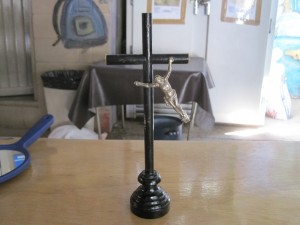Give me your tired, your poor….
I met a little boy today, probably 7 years old. He was running around at the comedor in shorts and a polo shirt, back and forth among the migrants and an older woman sitting in the corner. Occasionally he buries his head in the old woman’s lap. It turns out that this is his grandma. There is a little girl with a vacant look on her face—his sister, age 12. Transported from Florida to Nogales over the past few days, the children were separated from their mother during a pick-up by the Border Patrol in Florida.
Florida??!!
Their father is “somewhere in Mexico.”
So what are they doing here?
The children were deported to Nogales, Mexico, and sent to DEF, the Mexican equivalent of Child Protective Services. Their mother was sent to a detention center somewhere—maybe Texas, New Mexico, Arizona. No one seems to know. Upon questioning, the authorities learned that the children had a grandmother in Nogales, Sonora, and so the kids were transported to this shelter. Today, no one knows where their mother is—she is somewhere in the “system” between here and Florida.
Who thinks up these maneuvers? Some malevolent troll under a bridge?
I’ve seen the separation of families many times at the comedor. Women weeping because they do not know where their brother or husband or lover has been transported. This bit of human transport is supposed to discourage migrants from trying to cross the border another time. Ship them to Texas or California, separate the families, and make life even more unbearable than it already is.
So someone in our group whips out a cell phone and we begin calling various detention centers in Texas hoping to find at least one of their parents. A nun in a brightly colored apron comes out of the make-shift kitchen with a bowl of beans and fresh tortillas for the little boy and his grandma. She holds him close as he eats the refritos. I search through the clothes we have brought this week looking for little boy things. Nada. I find a flowery hair barrette for the little girl, who has the look of an old old soul. She smiles and whispers, “Gracias.”
The system of “repatriation” is complicated, I’m told.
I don’t care. This is just plain wrong, and it makes my blood boil.



Wow, Peg–you really capture the essence of what is happening at the comedor and the ongoing tragedy of U.S. immigration policies. Thanks so much for doing this blog. It’s evident it’s helping to raise awareness across the country of the consequences of our unjust U.S. immigration policies. I love your choice of photos too, especially the one for today!
Keep up the good work!
Sharon—-I enjoyed walking with you today to the comedor and sifting through all the clothes and shoes for the migrants. You have a lot of good insights about what we see. I appreciate your work with others in raising consciousness about the tragedy of our border and the plight of so many people. Looking forward to taking that long walk to the comedor in the future. –Peg
The story of these two children and their family vividly shows a repatriation policy gone crazy. I don’t know how the inhumanity of such actions can be justified…. certainly not because, “it’s complicated.” This inspires me to explore the most effective way to let those who can make a difference hear those who think it’s inhumane.
So many stories like this. I remember the re-uniting of three children with their parents at the Comedor last year. The parents were caught trying to return to Phoenix, AZ from a funeral in Mexico. What joy!! I have their pics which I have shown throughout the USA to show the plight of many Immigrants and their families.